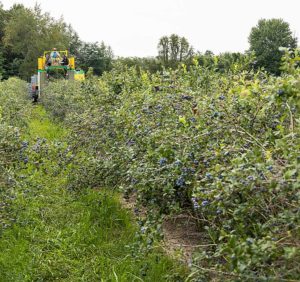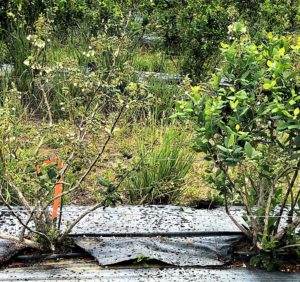Michigan State University small fruit and hop pathologist Timothy Miles would like to see blueberry growers mix more biological products into their spray programs. Biologicals might not be as powerful as the “big guns” — conventional products growers are used to using — but overreliance on a few powerful tools can lead to pesticide resistance.
Diversifying spray programs costs more and complicates management, but in the long run doing so offers the best strategy for effective pest management, he said.
Miles spoke during the Great Lakes Fruit, Vegetable and Farm Market EXPO in December. He discussed evolving management strategies for blueberry fruit rots, especially anthracnose, the top disease problem for Michigan blueberry growers.
Anthracnose fruit rot can harm yield, shelf life and fruit quality, and it can lead to unacceptable microbial levels in the field. Infections happen early, around bloom, and the pathogen reproduces quickly. Infected fruit fall off the bush, putting a massive amount of inoculum in the field. A single infected berry can contain 10 billion spores, he said.
Anthracnose control accounts for nearly half of the fungicides used in Michigan blueberries. The backbone of most spray programs includes Fungicide Resistance Action Committee (FRAC) groups 11, 9 and 12. Anthracnose has developed resistance to FRAC 11 fungicides, but not yet to other modes of action. Miles recommended a few strategies to manage fungicide resistance, including applying half rates, rotating FRAC groups, targeting sprays around bloom and using dormant sprays.
As for biological products, he said quite a few have proven to be effective in spray programs with other effective products, including Stargus (Bacillus amyloliquefaciens), Howler (Pseudomonas chlororaphis) and LifeGard (Bacillus mycoides isolate J).
Cultural practices help, too. These include pruning, improved weed control, adjusting overhead irrigation timing to minimize wetness and using drip irrigation. When the berries are ripe, pick them quickly, keep the fruit cool and don’t harvest when it is raining. Cultural practices mostly come down to keeping the plants as dry as possible, Miles said.
More long-term practices include wider plant spacing and planting resistant varieties. But even resistant cultivars, such as Elliott, can develop shoot infections. If resistant cultivars are planted close to susceptible cultivars, both should be protected with fungicides and pruned regularly, he said.
Miles also discussed alternaria fruit rot, considered to be more of a storage or spoilage disease. In postharvest situations, infections often occur on the stem scar, or calyx end, and quickly spread over the entire berry. To manage Alternaria, harvest quickly, keep fruit cool, don’t harvest when it is raining or when the fruit is wet, and use a preventive spray program, he said.
Effective fungicides for Alternaria include FRAC groups 7, 9, 11 and 12, Miles said.
—by Matt Milkovich








Leave A Comment